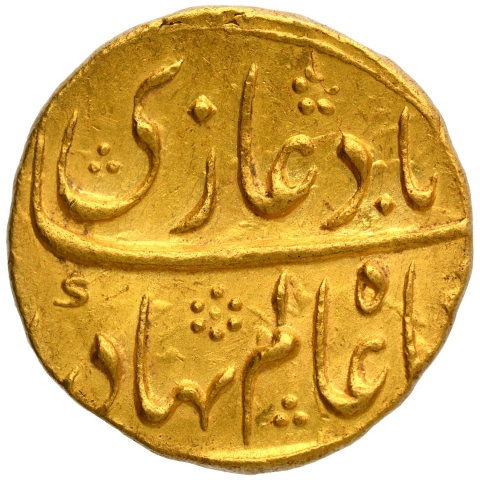This Lot is closed.
- P-Auction # 24
- Bids: 4
- Views:972
| Start Price 600000 | Estimated Price 600000-800000 |
| login, to view Hammer value | |
| Quick Description | ||||
|---|---|---|---|---|
| Denomination | Mohur 1 | Mint | Toragal | |
| Metal | Gold | RY (Ruling Year) | 4 | |
| Full Description: Shah Alam Bahadur, Toragal / Torgal Mint, Gold Mohur, 4 RY, Obv: sikka shah alam bahadur badshah ghazi, Rev: sana 4 julus, zarb torgal at bottom, 10.90g, 22.5mm, (KM # 356.15), almost uncirculated, Exceedingly Rare. After 1657 AD. the Mughals began slicing off Bijapur territory one after another. Before the fell of Bijapur in 1686 AD, there were many mints working in Sholapur and the South. By peaceful means and assurances Prince Muazzam (Shah Alam Bahadur) exercised greater influence over Bijapur government. His opposition to Diler Khan was the main instrument by which peace with Bijapur was established. Bijapur accepted the Mughal suzerainty. In March 1680 AD. at Bijapur the Khutbah was read and the gold and the silver coins were struck in the name of the Emperor Aurangzeb. It was the greatest success of the Mughals at the hands of Prince Shah Alam Bahadur. He succeeded in reducing Bijapur to vassal state, for which his ancestors failed to achieve even by military strategy. After the fell of Bijapur, in the new Subah of Dar-uz-Zafar Bijapur the Mughals established mints at many places like Bijapur, Ahsanabad (Gulbargah), Azamnagar (Belgaum), Azamnagar Gokulgarh (Gokak), Nusratabad (Sagar), Carnatic Nusratabad (Dharwar), Bankapur, Imtiyazgarh (Adhoni), Ferozgarh (Himmatgarh), Torgal, Chinapatan, Namol (Kamol or Qamar nagar) and Feroznagar (Raichur). On the deathbed Aurangzeb said to have left his last will under his pillow in which he gave directions for his own burial and for the partition of the Empire among his three sons Shah Alam Bahadur, Azam Shah and Kam Bakhsh. During this frequent fits of illness of Aurangzeb, Prince Azam Shah planned to remove his rivals (other princes) from his path for securing the Mughal throne for himself. In January 1707 he was sent to remedy the disorders of the Subah of Malwa. In the war of succession, against Shah Alam Bahadur (his elder brother). He died at Jajau, after fighting bravely on 8th June 1707 AD. The victorious Emperor Shah Alam Bahadur next paid his attention towards Kam Bakhsh, the surviving contender. Before direct encounter Shah Alam Bahadur wrote a kind and admonitory letter to Kam Bakhsh stating, "Our father entrusted you with government of two Subahs of Bijapur and Haidarabad with all their subjects and belongings upon the condition according to the old rule of the Deccan that the coins shall be struck and Khutbah read in our name. The tribute which has hither to been paid by the governors of these two Subahs we remit." However, the words of letter fell on deaf ears of Kam Bakhsh, who preferred to fight with only few hundreds of cavalrymen. In the battle fought near Haidarabad, Kam Bakhsh received severe injuries and died on 3rd January 1709 AD. Thus an attempt of Kam Baksh to acquire the throne of Delhi from Bijapur had failed. If he had satisfied with the Subahs of Bijapur and Haidarabad, he would have carved out kingdom of his own. And by this the Bijapur area came under Shah Alam Bahadur and coins were struck from all the nearby mints. An exceptional rare mohur of Torgal mint, probably offered for the first time! | ||||








